-

人教版新目标初中英语八年级下册How long have you been collecting shells教案2篇
Step Ⅱ Show the new words on the screen and teach the new words. Read the new words to students and ask them to repeat.Step Ⅲ 3aThis activity introduces new vocabulary and provides reading practice using the target language.In this activity first look at the four pictures.T: What can you see in the pictures?Ss: Four snow globes.T: Right. There are four snow globes in the pictures. And what are they?Ss: They are a monster, two polar bears, two penguins and a birthday cake.Write these words on the blackboard: snow globe; monster; polar bear; penguin and birthday cake. Read them to the class and ask students to repeat each one. Make sure students understand each word.Use a computer to show the E-mail message on the screen and read the message to students.Get students to read the e-mail on their own, and then draw lines connecting each snow globe and its description.Correct the answers.AnswersA line should connect each snow globe picture with the words that describe it in the letter.Step Ⅳ 3bThis activity provides writing practice using the target language.First review Activity 2a on Page 47.Then ask students to complete the message according to Activity 2a.Some partial sentences are given to students. Write about one person's collection.When students work, walk around the room checking the progress and offering help as needed.When they finish, ask some students to read their messages to the class.

人教版新目标初中英语八年级下册What were you doing when the UFO arrived教案2篇
(一).知识方面: 1.培养学生能运用过去进行时来描述、谈论过去某个时间正在发生的事情或动作的意识和能力,能就过去某个时间正在发生的动作做出正确的描述。 2.培养学生的想象力和角色扮演的合作能力。 3.培养学生讲述过去发生的事情经过的能力。能正确运用一般过去时来讲述故事。 (二).技能方面: 1.本单元的语言目标是Talk about past events and tell a story(谈论过去的时间和讲述一个故事),围绕这一目标,要涉及句型: What were you doing when the UFO arrived? ----I was sitting in the barber’s chair. The barber was cutting my hair. 因此必须学习standing、studying、cleaning、sleeping、cooking、making、eating、cutting、等表示地点的词,以便为上述句型提供语言材料。2.学习过去进行时的有关知识。Was/were+现在分词,是该时态的表达式。 3.在学习过程中,要区分The boy was walking down the street when the UFO landed.和While the boy was walking down the street, the UFO landed.这两种由when和while引导的状语从句的句型结构。注意它们的不同。

人教版新目标初中英语八年级下册Why don’t you get her a scarf教案
教师带领学生复习有关描述宠物的词汇,采用教师提问学生回答的方进行。如:T:What animals do you think would be good pets?What animals do you think would be bad pets?What do you think are good animals for a six-year-old child?然后学生进行 pairwork 练习。Task two: 师生互动,学习探究 1、播放3a部分的录音,引导学生一边听录音,一边跟读。2、通过听录音学生回答以下问题:Why do you think pot-bellied pigs are popular?What are the advantages and disadvantages of keeping such a pet?教师对学生的回答进行及时点评。3.学习范文,学习重点短语,为下步的模仿写作提供语言素材。T :1. )Have you ever kept a pig as a pet?Do you like pigs? St.:No.…Why don’t you like to keep a pig? St: No.They’re too dirty and lazy(Do you know in some foreign countries like Hollyland, Australia,pigs are the most popular pet.there’s a kind of pig.(图)it has an interesting name? it ‘s called a pot-bellied pig.) Now,let’s learn an article about this kind of interesting pet.2.)play the tapeSt.:Listen and repeat3.)show some Qs on computer(本子St.: read silently,then answerthe Qs(本子)4.)Ask ss. Close book and retell this passage.(what is a pot-bellied pig? Is it a good or bad pet? ) St.: retell it to each other“A pot –bellied pig is a popular pet now…”5.read the article together.St.:.practice reading

人教版新目标初中英语八年级下册Would you mind turning down the music教案
Step 4. Group work (4)1. Ask a pair of students to read the dialogue. Say, This activity provides speaking, listening and writing practice using the target language.2. Ask students to complete the work in groups.3. Check the answers with the whole class. 4. Explain some of the language points. Step 5. Word review (Self check 1)1. Ask students to read the words and the phrases given. 2. Fill in the blanks with proper forms of these words to complete the sentences. 3. Check the answers with the whole class. Homework:Do activity 2 on page 57 after class. Period 6Teaching aims: 1. Teach vocabulary words and the useful expressions. 2. Enable the students to learn etiquette in different culture. 3. Help the students learn how to behave politely in public places and in daily life. Teaching procedures:Step 1. RevisionHelp students to review the function of making requests through a free talk. Then lead them to the topic of etiquette. Explain the meaning of etiquette. Or, ask students to look it up in the dictionary. Step 2. Pre-reading (Section 1)1. Ask students to read the picture and make a list with their partner about how many rules of etiquette can be seen being broken.

人教版新目标初中英语九年级下册By the time I got outside, the bus had already left教案
Ⅰ. Teaching Aims and Demands1. Knowledge Objects(1) Key Vocabularyoversleep(2) Target LanguageWhat happened?I overslept. And by the time I got up, my brother had already gotten in the shower.2. Ability Objects(1) Teach the students to use the new words.(2) Train the students to narrate past events with the Past Perfect Tense.(3) Train the students' listening and speaking skills with the target language.3. Moral ObjectIt’s a good habit to go to bed early in the evening and get up early in the morning. So you’ll never be in a hurry in the morning.Ⅱ. Teaching Key Points1. Key Vocabularyoversleep2. Target LanguageNarrate past events with the Past Perfect TenseⅢ. Teaching Difficult Points1. Train the students to narrate past events with the Past Perfect Tense.2. Train the students to understand the target language in spoken conversation.Ⅳ. Teaching Methods1. Thinking of examples from the students' real lives.2. Making sentences by looking at the pictures.Ⅴ. Teaching AidA tape recorderⅥ. Teaching ProceduresStep I Revision1. Revise the language points in Unit 8.Ask some questions like this: What volunteer work would you like to do?Help the students to answer, I’d like to…/I love to…/I hope to2. Practice the dialogue in Activity 3c on page 62 again. Get students to role play the similar dialogues with the following.

人教版新目标初中英语九年级下册Could you please tell me where the restrooms are教案
Step Ⅰ RevisionCheck homework. Ask a few students to read the article in 3a.Then ask a few students to read their guides.Step Ⅱ Part 1Look at the words in the box. Ask a student to read them. Make sure the students understand the meaning of the words. You are to fill in the blanks with the words. In some cases, students may need to use another form of the word, for example adjusting for tense or subject/ verb agreement.Ask students to fill in the blanks on their own.Check the answers. Step ⅢPart 2Go through the instructions with the class.Look at the example with the students.Ask students what the answer would be.Ask a student to read the question and answer it.Excuse me, could you tell me where the bank is, please?The bank is across the street from the shopping malt.Get students to complete the work in pairs.Check the answers. Ask a few students to read their questions.Step Ⅳ Just for Fun!Ask all the students to read the conversation. Ask: What is funny about this cartoon? Help students to explain. A Martian is a person from the planet Mars.There is no such thing as Martian food on Earth, and the clerk looks silly because he is trying to think of where there is a Martian restaurant.Invite some pairs of students to present this conversation to the rest of the class.Step Ⅴ Summary and HomeworkIn this class, we’ve done much writing practice using the key vocabulary words and the target language presented in this unit. After class, please finish the questions in 2 in your exercise books. Then finish the exercises on pages 47~48 of the workbook as well.The Seventh Period Ⅰ Teaching Aims and Demands1. Knowledge Objects(1) Key Vocabularyimage, adventure, jealousy, hero, crime, journey, brave, no longer, show interest in, take it easy, become interested in, plain looks(2)Text:Grown-ups like cartoons, too.2. Ability Objects(1) Fast-reading to get a general idea of the text.(2) Careful-reading to get the detailed information in the text.

人教版新目标初中英语九年级下册We’re trying to save the manatees教案2篇
本单元主要围绕着有关濒临灭绝的动物这一话题,学习了应该怎样保护我们的环境,以及就某一问题展开辩论。目标提示语言目标能够运用所学知识,就某一问题展开辩论。认知目标1、复习一些语法:现在进行时、一般现在时、用used to 表示一般过去时、现在完成时、一般过去时的被动语态。2、学会表达同意和不同意。3、学会以下基本句型:We’re trying to save the manatees.Manatees eat about 100 pounds of food a day.There used to be a lot of manatees.In 1972,it was discovered that they were endangered.Some of the swamps have become polluted.情感目标了解一些濒临灭绝的动物的生活习性和濒临灭绝的原因,教育学生应该如何保护环境。教学提示充分利用多媒体等教学设备,创设与本课话题相关的情境,如各种不同种类的动物、动物园以及有关环境的画画等等。围绕着本单元的教学目标,设计一些贴近学生实际的教学任务,如让学生谈论自己最喜欢的动物,如何拯救濒危动物,如何保护环境等等。让学生根据所学知识,就动物园是否对动物有利以及其他的话题进行辩论。
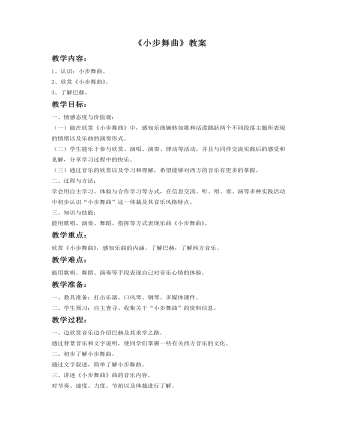
《小步舞曲教案》教案
教学过程:一、边欣赏音乐边介绍巴赫及其求学之路。通过背景音乐和文字说明,使同学们掌握一些有关西方音乐的文化。二、初步了解小步舞曲。通过文字叙述,简单了解小步舞曲。三、讲述《小步舞曲》曲的音乐内容。对节奏、速度、力度、节拍以及体裁进行了解。四、结合谱例分段学习《小步舞曲》。1、学习乐曲A’段。说明:依据乐曲创作背景,合理创设“舞会”情景,从而有效激发学生学习兴趣,用舞蹈表现手段演绎此乐段,发展了学生的舞蹈表演能力,享受到美的愉悦。2、学习乐曲B段。说明:利用形象、直观的图式辅助以及一系列贴近学生思维逻辑的问答讨论,激发学生的思考,帮助学生准确把握乐段情绪,并能用指挥、伴奏等方式表现该乐段。3、完整欣赏《小步舞曲》。说明:学生在完整欣赏乐曲时能够巩固乐曲主题的记忆,并且听辨、感受乐曲两个不同主题情绪,培养学生独立的音乐感受和见解。五、视频欣赏。说明:通过视屏欣赏,使同学们以一个更直观的郊区去理解和学习作品,并使同学对作品有更深刻的记忆。引起学生共鸣,领悟音乐的美感,愉悦身心,获取乐趣,从而激起学习的情趣。
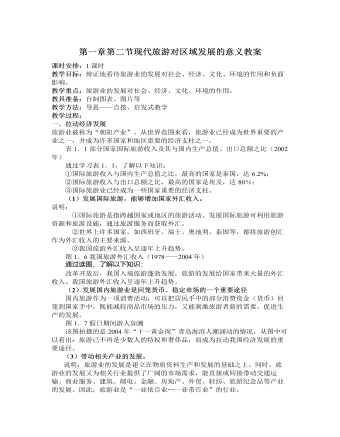
人教版高中地理选修3第一章第二节现代旅游对区域发展的意义教案
三、影响区域环境说明:环境是旅游业的基础,旅游对环境保护具有促进作用。世界上很多国家在发展旅游业的同时,都很重视对旅游资源和环境的保护,以实现旅游业的可持续发展。旅游业的发展对环境也有消极作用,如果旅游与环境的关系不处理好,环境也会朝着恶化的方向发展。图1.10古建修复图1.10对比显示古建筑修复前后景观的变化,说明旅游业的发展有利于文物古迹和古建筑的保护。讨论:1.列举旅游业发展有利于环境的措施。提示:建立各种自然保护区、申报历史文物保护单位等措施都有利于保护旅游环境。2.举例说明旅游对环境的消极作用。提示:旅游对环境的消极作用主要表现在:由于对旅游资源开发建设不当或失误,使生态环境恶化;由于大量游客的涌入,排放的各类废弃物超过了环境自净能力而造成环境污染;由于大量游客的接触或不文明行为引起的对风景、文物的破坏等。
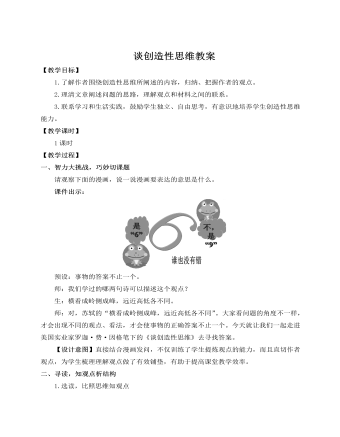
人教部编版语文九年级上册谈创造性思维教案
《谈创造性思维》是一篇自读课文,浅显易懂,这不仅是因为作者写作思路清晰,还在于作者巧妙运用了举例论证的写法。作者为了证明知识与创造力之间的关系,举了谷登堡将葡萄压榨机和硬币打制器组合起来发明了印刷机和排版术的事例,还举了罗兰·布歇内尔发明交互式的乒乓球电子游戏的事例,具体而又确凿地阐明了事理。但两者有所侧重,前者侧重于“活用知识的态度和意识”,后者侧重于“尝试”,这为我们写作议论文提供了典型的写作方向:举例,既要注重事件的典型性,也要重视事件的差异性,使论证更有说服力。[疑难探究]课文说:“区分一个人是否拥有创造力,主要根据之一是,拥有创造力的人留意自己细小的想法。”为什么这样说?从社会发展史上可以看出,伟人们的天才的创造,往往是从细小的想法开始的:牛顿创立万有引力学说,是从苹果落地的小想法开始的;瓦特发明蒸汽机,是从水壶里的水开了,水汽顶着壶盖的小想法开始的;法国大数学家庞加莱,说他关于数学的发明,大半是从“无意中得出来的细小的想法”开始的。
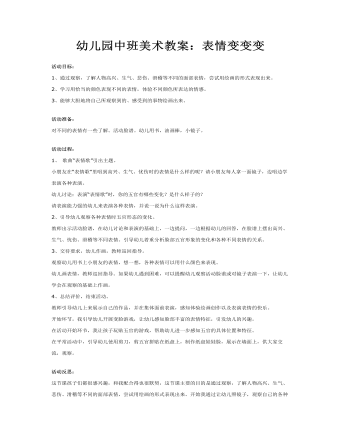
幼儿园中班美术教案:表情变变变
2、学习用恰当的颜色表现不同的表情,体验不同颜色所表达的情感。 3、能够大胆地将自己所观察到的、感受到的事物绘画出来。 活动准备: 对不同的表情有一些了解。活动脸谱。幼儿用书,油画棒,小镜子。 活动过程: 1、歌曲“表情歌”引出主题。 小朋友在“表情歌”里唱到高兴、生气、忧伤时的表情是什么样的呢?请小朋友每人拿一面镜子,边唱边学表演各种表演。 幼儿讨论:表演“表情歌”时,你的五官有哪些变化?是什么样子的? 请表演能力强的幼儿来表演各种表情,并说一说为什么这样表演。 2、引导幼儿观察各种表情时五官形态的变化。 教师出示活动脸谱,在幼儿讨论和表演的基础上,一边提问,一边根据幼儿的回答,在脸谱上摆出高兴、生气、忧伤、滑稽等不同表情。引导幼儿着重分析脸部五官形象的变化和各种不同表情的关系。
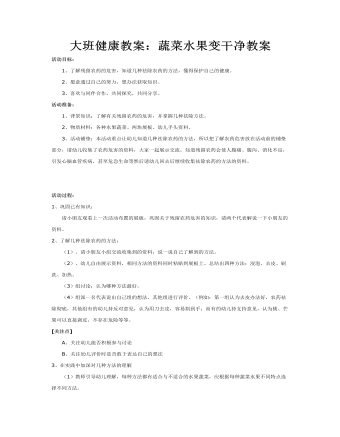
大班健康教案:蔬菜水果变干净教案
活动准备:1、背景知识:了解有关残留农药的危害,并掌握几种祛除方法。2、物质材料:各种水果蔬菜、两块展板、幼儿手头资料。3、活动铺垫:本活动重点让幼儿知道几种祛除农药的方法,所以把了解农药危害放在活动前的铺垫部分,请幼儿收集了农药危害的资料,大家一起展示交流,知道残留农药会使人腹痛、腹泻、消化不良,引发心脑血管疾病,甚至危急生命等然后请幼儿回去后继续收集祛除农药的方法的资料。
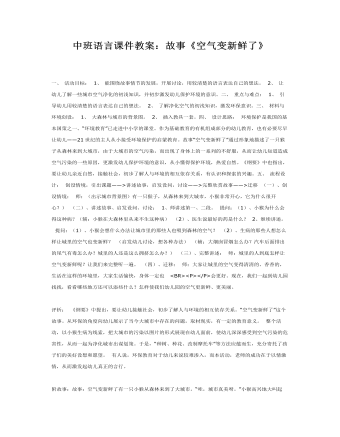
中班语言课件教案:故事《空气变新鲜了》
1、大森林与城市的背景图。 2、插入教具一套。四、设计思路: 环境保护是我国的基本国策之一。“环境教育”已走进中小学的课堂。作为基础教育的有机组成部分的幼儿教育,也有必要尽早让幼儿——21世纪的主人从小接受环境保护的启蒙教育。故事“空气变新鲜了”通过形象地描述了一只猴子从森林来到大城市,由于大城市的空气污染,而出现了身体上的一系列的不舒服,从而让幼儿知道造成空气污染的一些原因,更激发幼儿保护环境的意识,从小懂得保护环境,热爱自然。《纲要》中也指出,要让幼儿亲近自然,接触社会,初步了解人与环境的相互依存关系,有认识和探索的兴趣。五、流程设计: 创设情境,引出课题——>讲述故事,启发设问,讨论——>完整欣赏故事——>迁移 (一)、创设情境: 师:(出示城市背景图)有一只猴子,从森林来到大城市,小猴非常开心,它为什么很开心?) (二)、讲述故事、启发设问、讨论: 1、师讲述第一、二段。 提问:(1)、小猴为什么会得这种病?(辅:小猴在大森林里从来不生这种病) (2)、医生说最好的药是什么? 2、继续讲述。 提问:(1)、小猴会想什么办法让城市里的那些人也吸到森林的空气? (2)、生病的那些人想怎么样让城里的空气也变新鲜? (启发幼儿讨论,想各种办法) (辅:大烟囱冒烟怎么办?汽车后面排出的尾气有毒怎么办?城里的人还是这么拥挤怎么办?) (三)、完整讲述: 师:城里的人到底怎样让空气变新鲜呢?让我们来完整听一遍。 (四)、迁移: 师:大家让城里的空气变得清清的、香香的,生活在这样的环境里,大家生活愉快,身体一定也 会更好。现在,我们一起到幼儿园找找,看看哪些地方还可以添些什么?怎样使我们幼儿园的空气更新鲜、更美丽。

小班安全教案 幼儿园小班安全教案3篇
二、展开活动: 1、引导幼儿说出做车都应注意什么样的安全问题,孩子们回答(引导说出做自行车、电动车一定要把好扶手,脚不能乱动,坐摩托车时一定要带头盔) 2、出示课件,做公交车时要注意什么?图片中的小朋友做的对吗?为什么?(图片中的小朋友把头伸到了车窗外,这样太危险了) 3、坐车还要注意什么?(不能吃东西,不能在车上乱跑) 4、继续出示课件,在车上要系好安全带,12岁以下的幼儿要坐到安全座椅上,小朋友不能坐到副驾驶的位置上,在公交车上一定要抓紧扶手,注意前门上车,后门下车。
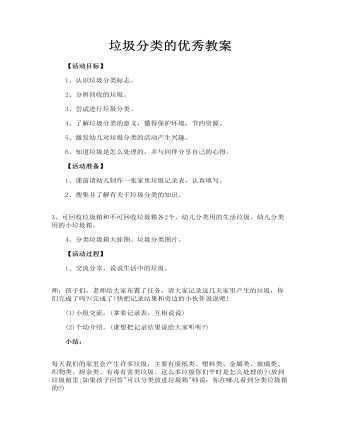
垃圾分类的优秀教案 垃圾分类优秀教案3篇
1、交流分享,说说生活中的垃圾。 师:孩子们,老师给大家布置了任务,请大家记录这几天家里产生的垃圾,你们完成了吗?(完成了)快把记录结果和旁边的小伙伴说说吧! (1)小组交流。(拿着记录表,互相说说) (2)个幼介绍。(谁想把记录结果说给大家听听?)
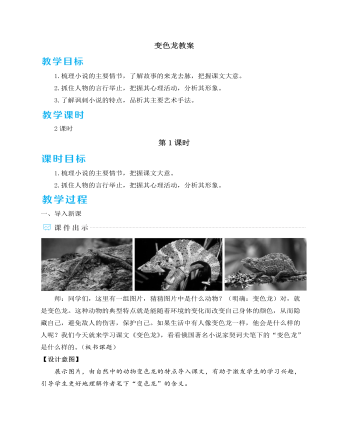
人教部编版语文九年级下册变色龙教案
3.注意环境描写对主题表达的暗示作用。小说中,环境描写也是为主题表达服务的,它有极强的暗示和埋伏笔作用。例如《变色龙》中的“四下里一片沉静。广场上一个人也没有。商店和饭馆的门无精打采地敞着”“门口连一个乞丐也没有”等环境描写,反映了沙皇专制统治下社会的萧条和死气沉沉。总之,理解小说主题的方法是多种多样的,不仅仅局限于以上所谈到的几个方面,我们在解读小说时要注意把虚构的内容与现实相结合,善于将小说与人生、社会、人性结合起来综合分析,这样才能更好地把握小说的主题。疑难探究席加洛夫将军及其哥哥在文中是个怎样的形象?在这篇小说中,席加洛夫将军及其哥哥这两个人物,始终没有出场,但是在围观群众及将军家厨子的口中却又无处不在。通过大家随着狗主人身份的变化而不断转变态度这一点,就可以看出当时社会中这两个人的霸道和权势熏天。就连他们家的一条狗,大家都惹不起,这是多么令人悲哀的社会现实。
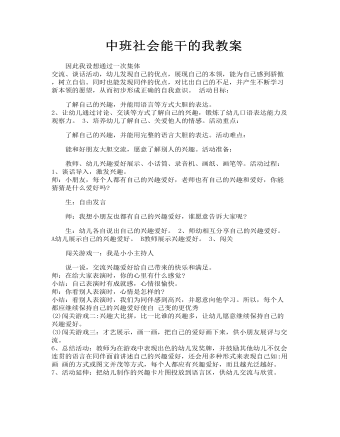
能干的小手中班教案中班社会能干的我教案
1、谈话导入,激发兴趣。 师:小朋友,每个人都有自己的兴趣爱好,老师也有自己的兴趣和爱好,你能猜猜是什么爱好吗? 生:自由发言 师:我想小朋友也都有自己的兴趣爱好,谁愿意告诉大家呢? 生:幼儿各自说出自己的兴趣爱好。 2、师幼相互分享自己的兴趣爱好。A幼儿展示自己的兴趣爱好。 B教师展示兴趣爱好。 3、闯关 闯关游戏一:我是小小主持人

北师大初中八年级数学下册分式的乘除法教案
通常购买同一品种的西瓜时,西瓜的质量越大,花费的钱越多,因此人们希望西瓜瓤占整个西瓜的比例越大越好.假如我们把西瓜都看成球形,并把西瓜瓤的密度看成是均匀的,西瓜的皮厚都是d,已知球的体积公式为V=43πR3(其中R为球的半径),求:(1)西瓜瓤与整个西瓜的体积各是多少?(2)西瓜瓤与整个西瓜的体积比是多少?(3)买大西瓜合算还是买小西瓜合算?解析:(1)根据体积公式求出即可;(2)根据(1)中的结果得出即可;(3)求出两体积的比即可.解:(1)西瓜瓤的体积是43π(R-d)3,整个西瓜的体积是43πR3;(2)西瓜瓤与整个西瓜的体积比是43π(R-d)343πR3=(R-d)3R3;(3)由(2)知,西瓜瓤与整个西瓜的体积比是(R-d)3R3<1,故买大西瓜比买小西瓜合算.方法总结:本题能够根据球的体积,得到两个物体的体积比即为它们的半径的立方比是解此题的关键.
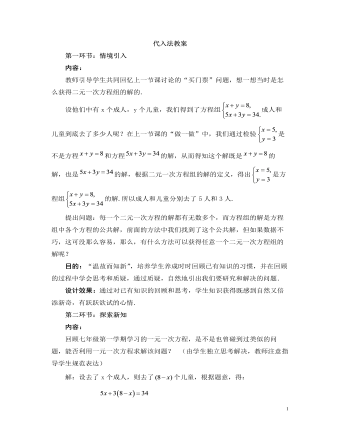
北师大初中数学八年级上册代入法2教案
第五环节:课堂小结内容:师生相互交流总结解二元一次方程组的基本思路是“消元”,即把“二元”变为“一元”; 解二元一次方程组的第一种解法——代入消元法,其主要步骤是:将其中的一个方程中的某个未知数用含有另一个未知数的代数式表示出来,并代入另一个方程中,从而消去一个未知数,化二元一次方程组为一元一次方程.解这个一元一次方程,便可得到一个未知数的值,再将所求未知数的值代入变形后的方程,便求出了一对未知数的值.即求得了方程组的解.目的:鼓励学生通过本节课的学习,谈谈自己的收获与感受,加深对 “温故而知新” 的体会,知道“学而时习之”.设计效果:学生能够在课堂上畅所欲言,并通过自己的归纳总结,进一步巩固了所学知识.第六环节:布置作业课本习题5.2教学设计反思1.引入自然.二元一次方程组的解法是学习二元一次方程组的重要内容.教材通过上一小节的实际问题,比较一元一次方程的列法和解法,从而自然引入二元一次方程组的代入消元解法.
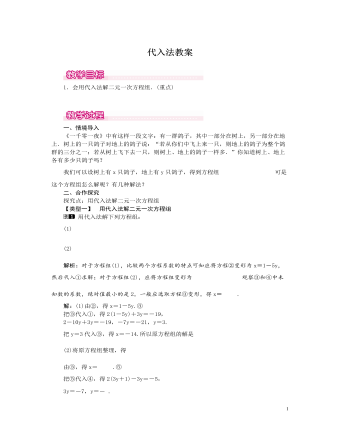
北师大初中数学八年级上册代入法1教案
【类型三】 已知方程组的解,用代入法求待定系数的值 已知x=2,y=1是二元一次方程组ax+by=7,ax-by=1的解,则a-b的值为()A.1 B.-1 C.2 D.3解析:把解代入原方程组得2a+b=7,2a-b=1,解得a=2,b=3,所以a-b=-1.故选B.方法总结:解这类题就是根据方程组解的定义求,即将解代入方程组,得到关于字母系数的方程组,解方程组即可.三、板书设计解二元一,次方程组)基本思路是“消元”代入法解二元一次方程组的一般步骤回顾一元一次方程的解法,借此探索二元一次方程组的解法,使得学生的探究有很好的认知基础,探究显得十分自然流畅.充分体现了转化与化归思想.引导学生充分思考和体验转化与化归思想,增强学生的观察归纳能力,提高学生的学习能力.

